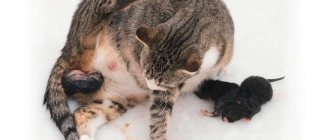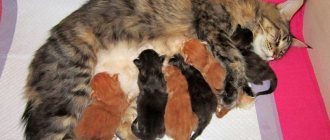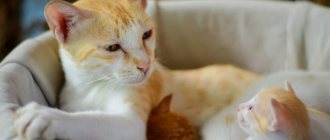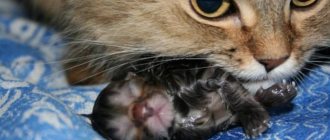11313Pavel
1
When deciding for the first time to start breeding Scottish Fold cats for commercial purposes or for themselves, the owner must know exactly everything about the birth of kittens. In most cases, the birth of a Scottish cat takes place without complications, and the four-legged mother only needs the support of the owner for a more comfortable birth of the kittens.
During pregnancy, a cat requires high-quality nutrition and careful monitoring of its condition. If the mating was the first and the Scottish female is still too young, she can give birth to only one kitten.
More mature cats that give birth more than once give birth to 5 to 7 kittens. The duration of labor in a normal course can last up to a day. Pregnancy lasts from 56 to 71 days, most often the birth of kittens occurs on the 65th day.
© shutterstock
Preparing the birth site
For the normal birth of kittens, a fold-eared cat, like any other, requires comfortable conditions. The birth box should be prepared in advance so that the pet has time to get used to it. It is very important that the environment in which the cat will give birth is homely and familiar to her. The birth box needs at least the following dimensions :
- length – 60 cm;
- width – 50 cm;
- height – 50 cm.
If the cat is very large, a larger box may be required. It is best to make one of its walls removable. This will allow, after the kittens are born, to carry out all the necessary actions to keep the bedding clean with the least amount of worry, and will also prevent the cat from jumping into the box from above, during which she could accidentally injure, or even kill, the kitten. The ideal bedding would be a thick layer of newspaper.
The kitten birth box should be placed in a warm, dry room in a dark place. The birth should take place without people or animals being strangers to the cat, which can become an additional source of stress for the Scottish cat, which will make the birth process more difficult.
Factors contributing to successful mating
Domestic cats become sexually mature at 6–8 months, depending on the breed and individual characteristics. Neither males nor females are ready for full mating in the first “hunt”. Stray animals mate at this age, which leads to death or infertility in an average of 30% of females, a reduction in sexual productivity in 50% of males - a natural way of controlling the birth rate and population of wild animals.
It is believed that the female is ready to bear kittens at the age of 1.3–1.5 years. For successful “cooperation” with a cat, the owners of the female need to take into account several points:
The search for a “spouse” may take a long time; you need to start 4–6 months before the planned mating. Remember that animals may not like each other, so have a backup plan.
Three months before mating, cats must be examined for infectious diseases, and tested for viruses a month before.
The cat is not vaccinated for 14–20 days.
Preventive deworming is carried out 14 days in advance.
Future partners do not bathe and trim their nails immediately before mating.
The meeting takes place on the territory of the cat; appropriate conditions must be prepared for the female.
First signs of labor
The first signs of labor in a Scots cat can be seen just before the kittens appear. It would not be amiss to note that in a British cat everything happens in a similar way. In the period before birth, about 30 hours before it, the cat's rectal temperature changes and is only 37 degrees instead of 38.6 (as usual), but it recovers within a few hours. This sign of approaching labor can sometimes be missed due to its transience.
On the day of birth, your pet’s behavior changes, she begins to actively lick the genital area, as well as the abdomen, becomes restless, actively purrs and rummages in the prepared box or place that she herself has chosen as a birthing area. The beginning of labor for tartans is considered to be the moment the plug comes out, which can be determined by the release of bloody clots or a brown jelly-like mass.
© shutterstock
Postpartum period
When a Scottish cat gives birth easily and without the intervention of a veterinarian, which is almost always the case, the pet does not require special care. In such a situation, after giving birth, she only needs to provide high-quality, sufficient nutrition and constant access to clean water , which will help cope with the blood loss that naturally occurs when kittens are born.
Every responsible owner can properly deliver his cat.
In the wild, cats are independent and can get by without human help. But if this is the first birth of a cat, especially a domestic cat, then often at that moment they do not understand what is happening to them. The natural instinct is so small that the owner’s help is needed not so much by the mother herself as by the newborn kitten. After all, it often happens that a mother cat, having barely given birth, leaves the nest out of fright, leaving an untreated baby. Therefore, our task is to know how to deliver a cat, help her, calm her down, and, if necessary, treat the kittens instead of her.
By the day your cat is expected to give birth (the Pregnancy Calendar will help you determine the exact date), you should already have everything you need ready. Read more about this in the article What is needed for a cat to give birth Now I will tell you about the signs of childbirth in a cat, I will write how cats give birth and how to care for newborn kittens. It is also important to know what to do if the cat is unable to give birth and the kitten is stuck.
But we must take into account that without veterinary education we can only help with uncomplicated childbirth. If you are not confident in your abilities, then arrange in advance with a veterinarian who is ready to come to your home.
Signs of labor in a cat
A cat's pregnancy lasts on average 65 days. On the eve of giving birth, the cat's stomach drops, the mammary glands swell and the so-called plug (yellow-brown mucus) comes out. A day or two before hour X, rectal body temperature drops from 38.6 to 37 degrees, but then returns to normal.
The cat's behavior changes before giving birth - she licks herself more often, especially the abdomen and genital area, she may become restless, meow more often, and dig in the maternity box or any secluded place. This is a very important and exciting moment for a cat, and on this day she needs your help and support more than ever. Therefore, you need to leave all emotions, calm down yourself and calm your pet.
Childbirth process
If a Scottish cat has given birth for the first time, we cannot rule out the possibility that she will get scared of what is happening and do something wrong. For this reason, you need to constantly be near your pet, calming it down and providing assistance if necessary.
The entire birth process can be divided into several stages:
- removal of the plug;
- contractions - during this period the uterus opens and the kittens line up in a certain order convenient for birth;
- pushing;
- the birth of the first kitten and subsequent ones;
- passing of the placenta.
It is important to remember that pushing continues all the time until all kittens are born.
Caring for a pregnant Scottish cat
As a rule, cats of the Scottish breed are very careful when bearing offspring: they are clean, sedentary, and rarely come into conflict with other pets living in the house. However, the owner of a Scottish Fold or Scottish Straight cat should remember these simple rules:
- The portion of food for Scottish women is increased by the end of the 3rd week of pregnancy. In this case, it is advisable to divide the entire volume of food into 4-5 equal parts. Midway through pregnancy, your cat will need half as much food as before pregnancy. At the final stage (from 7 to 9 weeks), the volume of food is reduced to the original amount;
- Cats that are accustomed to eating natural food need to include vegetables, herbs, vegetable oils, dairy products, cereals, and eggs in their diet. Sometimes you can pamper your pet with boiled sea fish. Every day it is advisable to feed the purr with high-quality meat (veal, chicken, rabbit). With a natural type of nutrition, it is advisable to give the cat multivitamins;
- Scottish females eating ready-made food can be switched to extra-premium products for pregnant and lactating cats;
- Cats should not be treated with medications without the consent of a veterinarian. Even a harmless medicine can harm babies;
- Confirmation of pregnancy and counting of kittens is best left to a specialist. Too zealous independent palpation often leads to intrauterine injuries;
- It is not recommended to let a pregnant Scottish woman go outside, where she can catch an infection;
- It is extremely undesirable to make a cat expecting offspring nervous. Fear and stress often lead to early labor, and therefore the health of premature kittens may suffer. Moving, rearranging furniture, a new pet, loud music - all this can unsettle a cat;
- When the Scottish cat’s pregnancy comes to an end, you should agree with the veterinarian about providing assistance if something during the birth does not go according to plan (the kitten will walk not with its head, but with its paws; the size of the baby will be too large given the miniature dimensions of the mother, etc. ).
Owner's actions during childbirth
If cats are bred by a cattery, then giving birth to a cat is nothing new for the owners, and they can accurately and quickly do everything necessary. Those who are giving birth to a Scottish cat for the first time need to prepare everything they need in advance and remember exactly the order of their actions.
It is important to calm the pet down and lay it on its side, as this position is the safest for newborn kittens and most comfortable for the cat. If the Scottish female tries to sit up, which sometimes happens in first-time mothers, this should be prevented, since otherwise both the kittens and the mother will be injured. Childbirth in a Scottish Fold cat usually takes place without extreme situations, which does not happen with all breeds.
As soon as the pet begins to give birth and contractions appear (they can be determined by the wave-like movements of the abdomen), she should be injected subcutaneously with 1 ml of Traumatine and Gamovit. You should not combine medications in 1 syringe. This is required to facilitate childbirth and quickly recover after it.
The first kitten born immediately begins to suckle from its mother, which stimulates labor and facilitates the birth of other kittens.
© shutterstock
When to start counting the pregnancy period
To understand how long the pregnancy duration of a Scots cat is for a given period, you need to know the exact date of mating of the cat. It is from this date that the first day should be counted. Naturally, if the mating took more than one day, then it is necessary to allow an error in the calculations of 1-2 days.
If for some reason you do not know when the mating was made, then you just have to wait for the first signs of pregnancy.
Symptoms and signs:
- The pet is gradually becoming rounder and gaining weight. Morning sickness and vomiting are possible. There are manifestations in the form of an apathetic state, lethargy and slight malaise. Changes in diet. The pet may begin to eat either more or less.
Helping a newborn kitten
When talking about how a Scottish cat gives birth, one cannot lose sight of the moment of providing assistance to a newly born kitten. Babies are born in a bubble, and if the cat does not immediately begin to care for them, the owner must do everything.
The sequence of actions will be as follows:
- rupture of the bladder at the level of the kitten’s nose;
- removing mucus from the nasal passages using a syringe (the nozzle of the syringe is carefully placed against the nostril and the mucus is sucked out, the procedure is carried out for both nostrils);
- dispersing blood from the umbilical cord with your fingers towards the kitten’s stomach;
- cutting the umbilical cord at a height of 2 cm from the baby’s tummy (you can rub the umbilical cord with your nails);
- Drying the newborn with a clean soft cloth.
Special veterinary training is not required for these manipulations. A healthy kitten begins to squeak and move actively as soon as it is dried.
After giving birth, the cat’s behavior returns to normal, and she begins to take care of the babies , which she was not interested in at the first moment after their appearance, due to a stressful state.
Stages of pregnancy
At the first stage, signs of pregnancy are not noticeable.
At the first stage, which lasts about two weeks, it is almost impossible to notice changes in the cat’s appearance.
Starting from the third week, a pregnant cat changes noticeably. Changes in hormonal levels provoke mood swings. The expectant mother can be very affectionate, or, conversely, show aggression. Also during this period, you should not carry the cat in your arms and allow it to jump from a height. If the cat needs to be moved, then one of your hands should be under its chest, and the other should hold its butt.
The fourth week of pregnancy is accompanied by a growth in the tummy and appetite. Murka eats more and more often, and she shouldn’t be denied treats.
In the fifth week, the cat noticeably becomes rounder. During this period, kittens begin to actively gain weight. The cat senses them and begins to look for a secluded place to make a “nest”.
Don't worry if this happens in the middle of the term. The expectant mother needs to get used to the house; she will spend a lot of time there.
From 40 to 50 days, kittens begin to acquire fur. Often the cat's appetite worsens and she becomes even more sleepy, spending even more time in the nest.
In the last weeks of the pregnancy, the pregnant cat begins to worry. She demands increased attention from her owner, and also restlessly searches the house in search of an even more comfortable place. If Murka often went for walks, now she spends more and more time at home.
By placing your hand on the stomach, you can feel the kittens moving. You can find out the number of babies using an ultrasound examination.
What to do with kittens?
Cats have a well-developed maternal instinct, so immediately after the birth of kittens, they independently gnaw the umbilical cord and provide full care for their offspring.
What help can the owner of a young mother cat provide:
- Kittens are practically blind after birth and bright sunlight can irritate their eyes. Try to find a suitable place in the house for the offspring, where there will be dim light, no drafts and no strong noise.
- For disinfection purposes, you can treat the kittens' umbilical cord with hydrogen peroxide or regular brilliant green.
- Make sure your mother cat licks her babies regularly. This process is very important, it improves the functioning of the kittens’ digestive organs and stimulates the sucking reflex.
- A mother cat feeds her babies with breast milk. You need to monitor this process and make sure that all kittens have access to the nipples and are fed.
- Newborn kittens must be kept in a warm room. If the room temperature is less than 28 degrees Celsius, install a heat lamp above the box with the babies. Just don’t point it directly at the babies, but slightly to the side to avoid burning the kittens’ delicate skin.
- If the mother cat does not have enough milk for feeding, organize complementary feeding. As additional nutrition, it is better to use special formulations from veterinary pharmacies, which are analogues of cat's milk. Your veterinarian will help determine the frequency of feeding kittens and the dosage of artificial milk.
- The box with the offspring should not stand at a height. This is very dangerous for growing children, who may unknowingly tip over the sides and fall, resulting in serious injuries.
For premature kittens, the doctor may prescribe a complex of drug therapy based on the administration of immunostimulating drugs and vitamins that promote good growth and proper development. Follow all doctor's orders!
KITTENS IN THE FIRST MONTHS OF LIFE
Kittens should be with their mother for the first two months. For those wishing to purchase a “kitten for the palm of your hand”, please note that when their pet gets to a new home, it will already be larger than the palm of your hand, because you will not give it away before 3 months. This will be humane both in relation to the children and in relation to the mother, whose kittens will not be taken away prematurely.
In the meantime, your task as a breeder is to provide all conditions for the babies. This is, first of all, a cozy, warm nest in an impenetrable place. This is a lack of increased interest on the part of family members and strangers. This is a minimal concern in terms of making sure their mother is feeding and washing them.
Pay special attention to whether there is enough milk for everyone. If you see that kittens are squeaking and crawling unsatisfied in search of the breast, although the cat seemed to be feeding them, this is a sign that there is not enough milk for everyone
Then you will need to feed with goat's milk or a special purchased formula for kittens in the first days of life. You will also have to feed them yourself if the mother is now unable to do this: for example, she had a caesarean section and is recovering from anesthesia, as happened with the cat in the video below.
Also look at whether the cat licks each baby. The fact is that newborn kittens themselves cannot empty their bladder and intestines, and stimulation by their mother’s tongue helps them with this. If the cat does not lick them in the area of the butt and tummy, thereby doing a massage, you will either have to do this carefully with one finger, or try to spread tasty oil (for example, fish oil) under the babies’ tails - the cat will immediately fall in love with the licking procedure.
Despite the fact that newborn kittens are completely blind and deaf, they can distinguish smells very well. They already remember and love the smell of your mother and yours, so before approaching the nest, we do not recommend smearing your hands with something odorous or choking yourself - this may alarm the family.
We need to talk separately about raising children. For the first month, this is done exclusively by the mother, because only she can do this now. In the first month of life, kittens are focused on communicating with their own kind, so your intervention may not be appreciated. During this period, your main task is to properly care for your mother and check that everyone has enough milk.
Starting from the second month, kittens are already able to pay attention to humans. At this time, they can be correctly directed so that they, for example, go to the tray
This is one of the most important skills that a breeder must instill in kittens before selling them, as this is what buyers look for. It is also worth starting to accustom them to the scratching post: the mother will show where to sharpen the claws, but you must prohibit them from doing this in other places - whenever you try to sharpen the claws anywhere, take the kitten to the scratching post, but under no circumstances beat or scold them .
From the second month of life, kittens already need complementary foods. It can be meat in pieces, but small ones. Fish is excluded during this period. The MURKOTIKI website wrote in great detail about the nutrition of small kittens in the article “What to feed a Scottish kitten.”
Nutritional Features
Feeding is the most important process in the first weeks of a baby's life. When the kittens are near the cat, they can at any time cling to the food source, but in its absence, you will have to provide the kitten with regular food - every 1-2 hours. In the first week of life, kittens eat little - a couple of spoons of milk, but often, so such a time interval is necessary.
Feeding a kitten with a syringe
Milk substitutes
It is recommended to feed newborn kittens with a cat's milk replacer. It is designed specifically for kittens, so its composition is balanced specifically for the growing cat’s body. It is believed that cat's milk is much more nutritious than cow's milk, therefore all the microelements and vitamins that kittens need at this age stage are added to the milk substitute purchased at a specialized pet store or veterinary pharmacy.
A special syringe for feeding kittens is often included with the milk replacer.
The packaging with the substitute always contains cooking instructions and a table indicating the ratio of the age or weight of the kittens and the dosage for one meal. All you need for feeding is a bottle and a nipple, which, as a rule, are included in the package with a milk replacer. If you don’t have these tools, you can always buy them in the same place as baby food or replace them with a pipette and a syringe without a needle. Sometimes the instructions for the substitute indicate that it is necessary to prepare it with bottled low-mineralized water, but if necessary, it can be replaced with filtered or settled boiled water.
You can read more about syringe feeding kittens below.
Feeding kittens with a syringe
How to feed kittens correctly?
Kittens, like human babies, need to be fed in an upright position to avoid injury. You need to press lightly on the bottle, but under no circumstances pour the milk mixture into the kitten - he must suck the “milk” himself. You can tell if the baby is full by his behavior: a hungry cat will squeak and crawl in search of his mother, and a well-fed cat will peacefully fall asleep.
An example of a milk replacer for kittens
Even if kittens live with a nursing mother, at the age of 3-4 weeks they should be introduced to complementary foods:
- low-fat cottage cheese;
- milk porridge;
- scraped meat;
- special delicate pates and mousses for kittens;
- dry food granules for kittens soaked in milk.
The amount of complementary foods should start with no more than 5-15 g and gradually increase. Complementary foods should be given before the main meal.
Possible complications of pregnancy, how to identify them in the early stages
Great risks are associated with mating after any kind of surgery. If a cat has survived anesthesia, its health has received a serious “blow” and you can start talking about mating only after the veterinarian’s permission and a comprehensive examination. In any case, mating is not planned until complete rehabilitation, sutures have been secured and scar tissue has formed.
Some cat breeds are notoriously problematic in terms of bearing offspring and childbirth. Pedigree breeders know about the pitfalls, but if you are not an experienced owner and have a purebred cat, be sure to consult the club about possible complications.
Bearing and giving birth to kittens in a British cat is associated with certain risks. The significant superiority in size of the male over the female, the majority of large kittens and the narrow pelvis of the cat can negatively affect the birth process. Problems are more common in Scottish cats due to genetic mutations. This does not mean that the animal is not able to give birth, but only that it needs to be given more attention and examined in detail. The Sphynx is a more problematic pet in terms of childbirth and new obstetricians are not recommended to deliver babies on their own. However, thanks to the control of widespread crossbreeding and the comparative “freshness” of the blood, only 10–15% of cats “fall” under caesarean section, which cannot be said about Persian, “new” Siamese, oriental cats.











